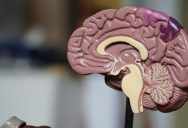New Technology Is Giving People Their Actual Voices Back Through A Brain Chip Implant And Artificial Intelligence

Scientists at UC Davis in Northern California have made a major breakthrough that could have a significant positive impact on the lives of people suffering with amyotrophic lateral sclerosis (ALS), also known as Lou Gehrig’s disease.
Using an incredible new brain-computer interface (BCI), 45-year-old Casey Harrell was able to communicate out loud using his own voice after years of slurred speech due to muscle control loss as an effect of ALS.
Using recordings from his life pre-diagnosis, scientists were able to train the voice assistant software connected to Harrell’s BCI artificial intelligence to sound like him prior to the disease taking hold of his body causing his speech to falter.
Implanted in the left precentral gyrus, the area of the brain responsible for speech, the BCI’s 256 electrodes record the area’s activity and work to convey the activity into text.
The text is converted to speech in mere seconds, allowing Harrell to communicate in near real time.
“We’re really detecting their attempt to move their muscles and talk,” said neuroscientist Sergey Stavisky, an assistant professor in the Department of Neurological Surgery and co-principal investigator of the study. “We are recording from the part of the brain that’s trying to send these commands to the muscles. And we are basically listening into that, and we’re translating those patterns of brain activity into a phoneme — like a syllable or the unit of speech — and then the words they’re trying to say.”
The initial test used a 50 word vocabulary, achieving a 99.6% success rate in just 30 minutes.
“The first time we tried the system, he cried with joy as the words he was trying to say correctly appeared on-screen. We all did,” Stavisky said.
In the second session, the size of the potential vocabulary increased to 125,000 words, with the BCI achieved a 90.2% word accuracy. After continued data collection, the BCI has maintained 97.5% accuracy.

Though this version of the technology is new, text to speech certainly isn’t.
Theoretical physicist and author Stephen Hawking used a specialized microprocessing computer powered by Intel to speak after an emergency tracheotomy in 1985, but the UC Davis scientists believe their version is better as it was built with natural speech flow in mind.
“Previous speech BCI systems had frequent word errors,” explained UC Davis neurosurgeon David Brandman, the principal investigator in the experiment and the co-senior author of the study published this week in the New England Journal of Medicine. “This made it difficult for the user to be understood consistently and was a barrier to communication.”
“Our objective,” Brandman continued, “was to develop a system that empowered someone to be understood whenever they wanted to speak.”

The technology has other uses, as well.
In 2023, for example, a 36-year-old German man, who was fully paralyzed by the condition, had a BCI implanted — and immediately asked for a beer when it allowed him to spell out messages.
It’s a true life-changer, in many ways.
“Not being able to communicate is so frustrating and demoralizing. It is like you are trapped,” Harrell said. “Something like this technology will help people back into life and society.”
This technology is giving people back their voice – and their life.
If you enjoyed that story, check out what happened when a guy gave ChatGPT $100 to make as money as possible, and it turned out exactly how you would expect.

Sign up to get our BEST stories of the week straight to your inbox.




